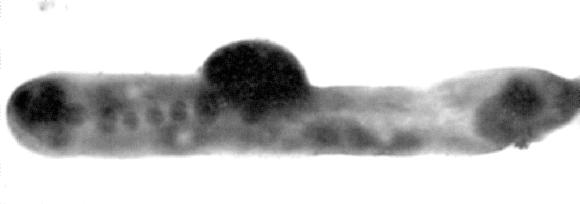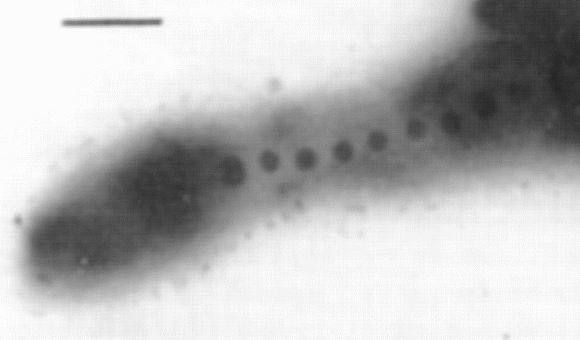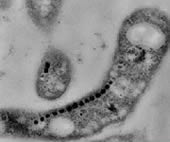Fossilized Magnetotactic Bacterium in the Orgueil Meteorite What'sNEW
In 1966, W. C. Tan and Sam L. VanLandingham examined samples of the Orgueil meteorite. Orgeuil is a carbonaceous meteorite like the Murchison meteorite (but Orgueil lacks chondrules). It was seen as it fell near Orgueil, France, on May 14, 1864. Samples of it have been extensively studied, especially by Bart Nagy, whose photos of lifelike fossils in it were published in Nature, in the early 1960s (1). The above photo was among several dozen by Tan and VanLandingham of fossils in Orgueil that looked biological to them. It was among a handful published in a brief article in the Journal of the Royal Astronomical Society, in 1967 (2). In those days, Tan and VanLandingham had no idea what the "filamentary microstructures" like this one might be, because they had never heard of magnetotactic bacteria. Today however, we do know about such bacteria. They ingest iron and retain it in particles which cause the bacteria to align themselves with a magnetic field. If enough of the bacteria become fossilized together, the product will be a "natural magnet". Sam VanLandingham says that the Orgueil sample in which the fossil was found had many similar fossils, all neatly aligned. When seen through a transmission electron microscope, the most striking feature of magnetotactic bacteria is the magnetosomes inside them. These membrane-bound particles of magnetite (iron oxide) or greigite (iron sulfide) appear as dark, regularly spaced inclusions whose geometry and spacing vary from one species to another. (In this example they resemble dark portholes on a tiny submarine.) The picture below shows a typical magnetotactic bacterium, of the species Rhodopseudomonas rutilis. Its size and shape are very similar to those of the fossil above. Most telling, however, is the match in size, shape and spacing of the magnetosomes. In 1998, NASA's Richard Hoover first showed the above photo to Russian bacteriologist Mikhail Vainshtein, who studies magnetotactic bacteria. He recognized it immediately. The photo below came from Vainshtein's collection (3).
The fossil from the Orgueil meteorite, photographed in 1966, was first identified as a magnetotactic bacterium like the one in the lower photo only this year [1998]. We suggest that this evidence of a fossilized bacterium in a carbonaceous meteorite cannot be easily dismissed.
1. Dr. George Claus and Prof. Bartholomew Nagy, "A Microbiological Examination of Some Carbonaceous Chondrites," p 594 v 192 Nature, 18 Nov 1961 [local pdf].
| ||||


